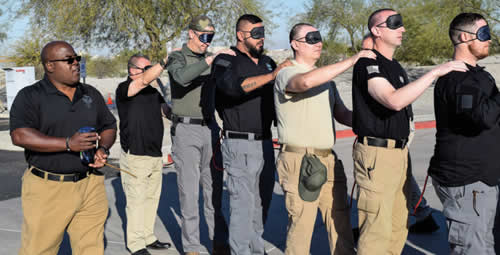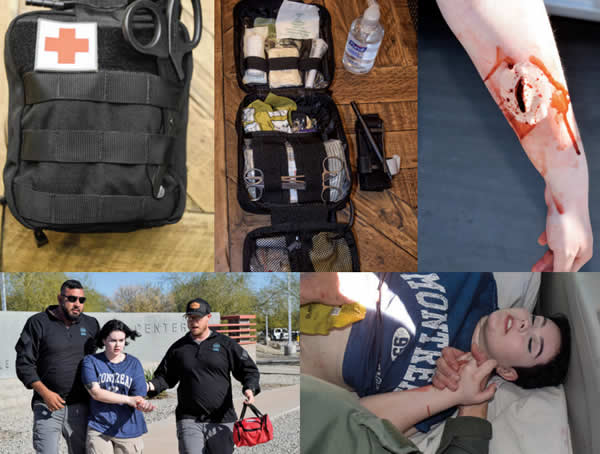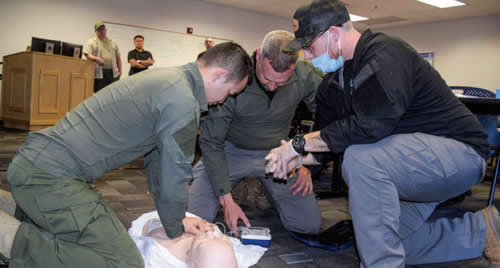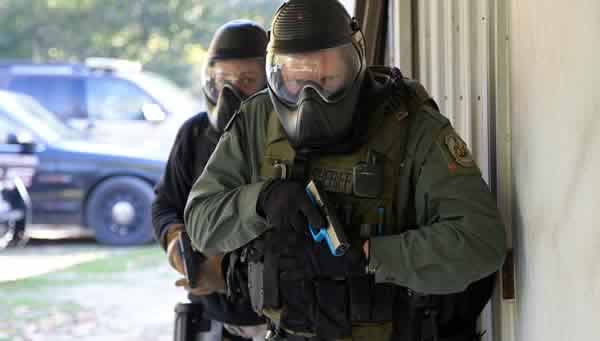Dignitary Protection Course Serves up Tie-Ins for Family Safety
In-depth Karl de la Guerra, Inc. class a chance to learn tactics, train with top-shelf instructors.
Story and Photos by Paul Pawela
tethered together blindfolded and the team leader directs his team through obstacles, while
the other members relay what is being said, which works well in all emergency scenarios.
If I were to ask each of you individually what your most valuable investment is, many of you would
state your house, a vehicle, or property. Of course, all of those are huge expenses and very valuable. The
only problem with that response is that it’s the wrong answer. Why? Because who are you buying that home for, that vehicle for, or that property for?

control on a principal (played by Wallace) when a threat presents itself.
Of course, the answer is your family. Your family will always be your number one valuable investment. And like any other investment out there, you should know how to properly protect it. We have a propensity to go to great lengths to protect our valuables and our property, and yet for our most important valuable, our family, we do very little in the way of protection.
Consider this quote (source unknown) for a moment: “Most people don’t want to be part of the process, they just want to be part of the outcome. But the process is where you figure out who’s worth being part of the outcome.” Could that not be applied to the family?
Remember these words when you think about what you and the rest of your family would need to do in the event of a critical crisis situation like an earthquake, tornado, fire or hurricane.
What about more personal critical crisis incidents such as an active shooter situation, an armed robbery or
a home invasion?
In your family, who has which specific jobs, tasks and responsibilities if any of the above scenarios takes
place? Is there even a plan? If the answer is no, then why not? It’s time to get prepared and get one.

Tactical Emergency Casualty Care Course, which was
simulated in a vehicle in one of the scenarios.
So where can you find the best sources to get the professional information that you need? This information has been discussed before in the pages of American Shooting Journal and the answer has always been, in my opinion, the personal protection specialists, aka the bodyguards.
Previously we discussed the overseas contractor who protects government dignitaries and other high-value government assets. Now we will consider the personal protection specialist whose focus is on the
corporate world and is responsible for the CEOs of major corporations and their families. For that task, there are few finer organizations than that of Karl de la Guerra, Inc., or KDI for short.
DE LA GUERRA is a 41-year veteran of the protective services industry and is the founder and CEO of KDI. Recently I had the honor and privilege of attending the Basic KDI 40-Hour Personal Protection Course in Arizona, and what a course! De la Guerra has amassed one of the most impressive cadres of instructors
in the business. In our class, we had two retired US Secret Service agents, one retired FBI/Special Forces officer, and the lead instructor was a personal protection officer who specialized in protection in hot spots in Africa. The other KDI instructors who taught were handpicked for their individual specialties and superb professionalism.
The course syllabus was rock-solid and included the following subjects:
• Team movement and formations;
• Bussing and debussing;
• Airport and hotel event operations;
• Protective driving;
• Counter assault team operations;
• Auditorium tactics;
• Tactical emergency casualty care;
• IED (bomb) recognition and
sweeps;
• Low-visibility operations;
• Advanced tactics and
considerations;
• And practical tactics and
considerations.

being trained and certified in CPR and immediate first aid.
All of this led up to a practical exercise where you were part of a protection team and bounced all over
the place to guard your client. Many readers might think that a course like this would not apply to
them because they don’t have the manpower or the budget to do this kind of dignitary protection for their own families. But they would be wrong. One of KDI’s quotes (a different one was written on the board each day) perfectly addressed this issue.
“Warriors are not always the fastest or strongest men. Strength and speed can be developed through training. Warriors are those who choose to stand between their enemy and all that he loves or holds sacred.” In the course outline above, every single topic that we covered – with the exception of
bussing/debussing – should apply to any family that is serious about working as a protective detail team in the event that a bad situation arises. And how often might that be? According to de la Guerra, 1 out of
15 people in the executive protection business will be in a violent confrontation; for the average civilian,
it is 1 out of 300.
IF ONE LOOKS at the KDI curriculum and simply turns it into a little modified version to flow with the family’s daily life, we would start with vehicle operations. Consider the vehicle the mobile command post for all our everyday operations.
First, is the vehicle clean inside and out? How is the vehicle’s mechanical condition? Consider oil, tires, power steering fluid, belts, radiator fluid, wipers, brake lights, flashers, headlights and horn. Does everyone on the team know how to fix a flat tire? Do you have a GPS as well as road maps – and does your family know how to read a map? Do you have jumper cables and secondary lighting/road flares? Do you have a bug-out bag with extra food, water and clothing?
Next is communication for team movement from point A to point B. Important things to be aware of the schedule of departure/arrival times; travel times and distances to and from determined travel sights; conditions that could a ect the regular route (have a contingency plan and know secondary routes if going long distances); and nearby hospitals, hotels and any other important areas along your route.
Is everyone on the protection team aware of the principal’s health and/or the special needs of the family? Is the protection team trained and certified in CPR and immediate first aid? Is the medical bag up to date with all needed medical supplies?
In the KDI course, all these topics were thoroughly addressed in professional detail because that’s the nature of the business for the protection specialist, but shouldn’t we do the same for our own family with equal vigor? Of course, many people wanted to learn the hand-to-hand and shooting training methodologies of the protection specialists and these were taught by KDI sta with excellent precision. But while those skills are very important, so too are the skills of learning how to avoid threats and dangerous situations altogether, like recognizing a potential threat’s body language or unusual behaviors, noticing
any protruding bulges in their clothing where he/she may have possible weapons, and observing any suspicious bags that could contain weapons.
One of the most interesting safety tips I came across in the KDI protection course was from an interview I was doing with an undercover Homeland Security officer, who told me he plays a game with his kids to see if they can spot people who are carrying weapons on their person.
It reminded me of how the people in Israel train their children to watch people with backpacks and bags; if someone sets one of their bags down, children are taught to pick it up and hand it right back to the person who left it because it just might be a bomb. With all the guns in this country, shouldn’t we be teaching our children how to spot people who carry them? We may not be able to plan for everything that is uncertain in our life, but we can increase our levels of awareness and preparedness. With the world’s issues today – all types of wars, a predicted economic collapse,
skyrocketing crime – isn’t it about time we start learning how to take personal protection seriously?
When it comes to this type of training, there is none better than KDI. For more info, go to teamKDI.com. Rest assured, American Shooting Journal will go into more depth on personal protection matters in future issues.
Editor’s note: Author Paul Pawela is a nationally recognized firearms and self-defense expert.






